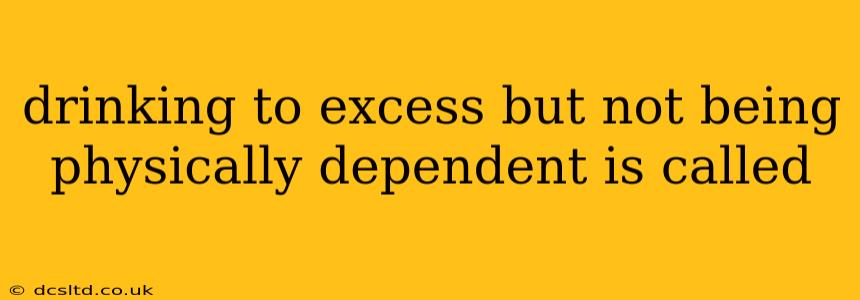Many people associate alcohol problems solely with physical dependence (alcoholism). However, excessive drinking can be incredibly harmful even without the presence of physical withdrawal symptoms. This problematic drinking pattern, where someone consumes alcohol in amounts that negatively impact their life, but doesn't meet the criteria for a physical dependence, is often referred to as harmful use of alcohol or alcohol abuse. It's a serious issue with significant consequences, and it's crucial to understand its characteristics and potential impact.
What is Harmful Use of Alcohol?
Harmful use of alcohol refers to a pattern of drinking that causes damage to one's health, relationships, or overall well-being. This damage can manifest in various ways, including:
- Physical health problems: Liver damage (even without cirrhosis), increased risk of certain cancers, heart problems, weakened immunity, and digestive issues.
- Mental health problems: Increased risk of depression, anxiety, and other mental health disorders. Alcohol can worsen existing conditions or trigger new ones.
- Relationship difficulties: Strained relationships with family, friends, and romantic partners due to erratic behavior, arguments, or neglect.
- Financial problems: Loss of income due to missed work, legal troubles, or increased expenses related to alcohol consumption.
- Social problems: Difficulties at work, school, or in social situations due to impaired judgment or behavior.
- Legal problems: DUI arrests, domestic violence charges, or other legal consequences stemming from alcohol-related incidents.
It's important to note that someone can experience these negative consequences without experiencing physical withdrawal symptoms upon cessation. This is a key differentiator between harmful use and alcohol dependence.
What's the Difference Between Harmful Use and Alcohol Dependence?
The distinction between harmful use and alcohol dependence (alcoholism) lies primarily in the presence or absence of physical dependence.
Harmful use involves drinking patterns that cause significant harm but don't necessarily lead to withdrawal symptoms if drinking stops. The individual may be able to control their drinking to some extent, but the consequences are still severe.
Alcohol dependence (or alcoholism) involves both harmful use and physical dependence. This means the individual experiences withdrawal symptoms (like tremors, anxiety, seizures, or hallucinations) if they attempt to stop drinking. They also exhibit a strong compulsion to drink and often have difficulty controlling their alcohol intake.
Is Harmful Use a Serious Problem?
Absolutely. Even without the dramatic physical withdrawal symptoms associated with dependence, harmful use of alcohol can have devastating consequences. The cumulative effect of excessive alcohol consumption, even without physical dependence, significantly increases the risk of various health problems and severely impacts an individual's quality of life.
How is Harmful Use of Alcohol Diagnosed?
Diagnosis usually involves a combination of:
- Self-reporting: Individuals describe their drinking habits and any related problems.
- Physical examination: Doctors check for signs of organ damage or other health problems related to alcohol use.
- Blood tests: May be used to assess liver function and other health markers.
- Psychological evaluations: Help assess the impact of alcohol on mental health and overall functioning.
What are the Treatment Options for Harmful Alcohol Use?
Treatment for harmful alcohol use varies depending on the individual's needs and the severity of their problems. It might include:
- Counseling: Helps individuals understand the reasons behind their drinking and develop coping strategies.
- Support groups: Provide a supportive environment and connect individuals with others facing similar challenges.
- Medication: Some medications can help reduce cravings or manage withdrawal symptoms (even if mild).
- Lifestyle changes: Adopting healthier habits, improving sleep, and managing stress can significantly improve outcomes.
It's crucial to seek help if you or someone you know is experiencing harmful alcohol use. Early intervention can significantly improve the chances of a positive outcome.
Can Harmful Alcohol Use Lead to Dependence?
Yes, harmful alcohol use can progress to alcohol dependence over time. Continued excessive drinking increases the risk of developing physical dependence and tolerance. Therefore, addressing harmful alcohol use promptly is crucial to prevent it from escalating.
Where Can I Find Help for Harmful Alcohol Use?
Numerous resources are available to help individuals struggling with harmful alcohol use. This might include:
- Primary care physicians: Can offer initial assessments and referrals.
- Mental health professionals: Provide counseling and therapy.
- Addiction treatment centers: Offer specialized programs for alcohol abuse.
- Support groups like Alcoholics Anonymous (AA): While primarily for those with dependence, some find the support beneficial even without physical dependence.
Remember, seeking help is a sign of strength, not weakness. There is hope for recovery, and professional support can make a significant difference.
